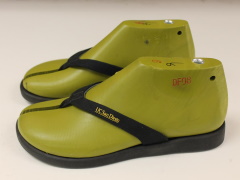Features
When are flip-flops like optical fibers?
Date: 2020-08-14 10:40:41.0
Author: Jon Evans

Flip-flops made from algae-derived material.
Photo courtesy of Stephen Mayfield, UC San
Diego.
On the face of it, flip-flops are nothing like optical fibers, but it turns out they do have something in common, because they can both be produced from algae-derived material. What is more, unlike conventional flip-flops and optical fibers, the algae-derived versions are biodegradable, offering a range of benefits for both the environment and us.
For the flip-flops, it’s the oil that can be extracted from algae that is of interest. More commonly, this oil is used a source of nutritional supplements such as omega-3 or converted into biodiesel. But a team of US researchers led by Michael Burkart and Stephen Mayfield from the University of California, San Diego has developed a process for converting the oil into polyurethane, which is what the soles of flip-flops are made from. This process involves converting palmitic and palmitoleic acid in the oil into azelaic acid, which can then be used as a building block for polyurethanes.
Now, the production of flip-flops may appear to be a rather frivolous use for this process, seeing as polyurethane is used to produce a wide range of other products, including foam for mattresses and sofas, thermal insulation and plastic moldings. But flip-flops are actually the world’s most popular shoe, because they’re cheap and fairly disposable, but this also means that huge quantities end up as plastic waste in landfills and the wider environment. And because conventional polyurethane is made from fossil fuels, these flip-flops don’t biodegrade.
But will algae-derived flip-flops biodegrade? Because to produce polyurethane, the azelaic acid needs to react with a compound known as a diisocyanate, which at the moment still needs to be obtained from fossil fuels. This means the algae-derived flip-flops only comprise 52% natural material.
Fortunately, as Burkart, Mayfield and their team reveal in a paper in Bioresource Technology Reports, it turns out that they do. When the researchers buried their flip-flops in compost or soil, the shoes would biodegrade within 16 weeks. Furthermore, they biodegraded back into azelaic acid and diisocyanate, which could then theoretically be used to produce new polyurethane, providing a completely closed loop.
If anything, optical fibers are even easier to produce from algae than flip-flops, because they’re made from agar, a transparent gel that can be created by simply boiling algae. Optical fibers transmit light by confining it between two materials with different refractive indexes. In conventional optical fibers, these materials are a glass core surrounded by a polymer coating, with the light trapped within the core, but they can theoretically be any two materials with different refractive indexes, as long as one of them is transparent.
To produce optical fibers from agar, the team of researchers from Brazil and Japan, led by Eric Fujiwara at the University of Campinas in Brazil, poured hot, liquid agar into a long glass tube containing six rods arranged in a symmetrical pattern in the center. The agar solidifies as it cools to produce a long transparent fiber, around 3mm wide, punctured by six regularly spaced tunnels, each around 0.5mm wide, in the center, formed by the rods.
In this optical fiber, light travels through the tunnels in the core, confined by the difference in the refractive index between the air in the tunnels and the agar fiber. As the researchers report in a paper in Scientific Reports, this fiber could efficiently transmit red light, although not as efficiently as conventional optical fibers. But it had other advantages.
For a start, the agar would swell or shrink in response to variations in humidity, temperature and pH, changing its refractive index and thus allowing the fiber to act as an optical sensor. And because it is entirely made of agar, the fiber should also be biodegradable, making it ideal for applications that involve shining light inside the body for imaging or treatment. Rather than having to surgically remove the optical fiber after use, the algae-based fiber could just be left inside the body to break down naturally.
The views represented here are solely those of the author and do not necessarily represent those of John Wiley and Sons, Ltd. or of the SCI.
Displaying 2 keywords used to tag this article:
- Jules Audemars-Australia Best Quali
- DG6582 Mens Moncler Down Jackets Gr
